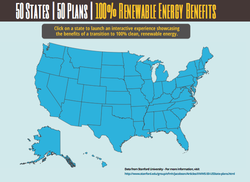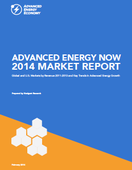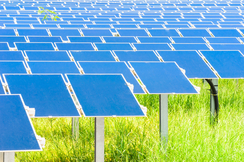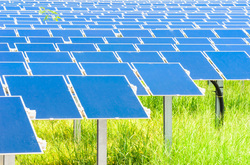

|
|
Studies Highlight Benefits of Renewable Power and Energy Storage for Latin America and Caribbean3/20/2014
 Two recent technical papers published by the InterAmerican Development Bank highlight the economic and societal benefits of renewable energy and energy storage technologies to Latin America and the Caribbean: Societal Benefits from Renewable Energy in Latin America and the Caribbean and Potential for Energy Storage in Combination with Renewable Energy in Latin America and the Caribbean.
 In 2013, the US added nearly twice as much solar generation capacity as coal—2,936 MW of solar compared to 1,543 MW of coal—according to data from the Federal Energy Regulatory Commission.  Based on data from Stanford University, a new study presents roadmaps for each of the 50 United States to convert their all-purpose energy infrastructure(for electricity, transportation, heating/cooling, industry) to ones derived entirely from wind, water, and solar (WWS) power generating electricity and electrolytic hydrogen after energy efficiency measures are accounted for. The numbers of devices, footprint and spacing areas,energy costs, numbers of jobs, air pollution and climate benefits, and policies needed forthe conversions are provided for each state. The plans contemplate all new energy powered with WWS by 2020, about 80-85% of existing energy replaced by 2030,and 100% replaced by 2050.  The Advanced Energy Now 2014 Market Report is the first annual report of market size, by revenue, of the advanced energy industry, worldwide and in the United States. As defined by Advanced Energy Economy (AEE), a national association of business leaders with the goal of making the global energy system more secure, clean, and affordable, advanced energy is a broad range of technologies, products, and services that constitute the best available technologies for meeting energy needs today and tomorrow. Prepared for AEE by Navigant Research, Advanced Energy Now 2014 reports that, for 2013, advanced energy reached $1.13 trillion in estimated global revenue, a 7% increase year-over-year driven by growth in six of the seven segments. Fluctuation in the worldwide total for advanced energy was largely driven by a peak year for large hydro projects in 2011 followed by a large decline in 2012, then slow growth in 2013. In the United States, the advanced energy market was an estimated $168.9 billion in 2013, 15% of the global advanced energy market, up from 11% in 2011. Excluding wind, U.S. advanced energy revenue grew 18% from 2011 to 2012 and 14% from 2012 to 2013. Wind energy suffered a severe, $23 billion revenue downward swing between 2012 and 2013, due to policy uncertainty around the federal Production Tax Credit (PTC). The effect of wind’s downturn is that U.S. advanced energy revenue declined 2% overall in 2013, following a 26% increase from 2011 to 2012.  Caribbean nations, including St. Lucia, Turks and Caicos and the British Virgin Islands, committed last week to start replacing diesel generators, the most common means of producing electricity on islands, with renewable sources like wind, solar or geothermal. Because diesel must be imported, the cost of electricity on the islands is generally very high, which makes renewable alternatives economically as well as environmentally attractive. The countries signed the pact at a multiday meeting organized by the Carbon War Room, a nonprofit organization that Richard Branson, the billionaire founder of the Virgin Group, established to fight climate change. More here. Brazil: Presidential Candidate Proposes Clean Energy Incentives in Run Up to October 2014 Election2/5/2014
 Brazilian presidential candidate, Eduardo Campos, proposed incentives for renewable energy in a set of guidelines outlining his new coalition’s policies. The guidelines include tax, fiscal and credit incentives to spur wider use of clean energy, according to Bloomberg. Campos is currently the governor of Pernambuco state, which held Brazil's first solar-only auction in December 2013. Former environment minister Marina Silva, best known as a champion for conservation of the Amazon forest, forged an alliance in October 2013 with Campos’s Brazilian Socialist Party. Report: 200 Actions President Obama Can Take to Accelerate U.S. Transition to Clean Energy Economy1/21/2014
 A new report from the Center for the New Energy Economy recommends more than 200 actions that President Obama can take to accelerate America’s transition to a clean energy economy – actions the authors believe can be implemented within the President's existing executive branch power. The recommendations were developed by more than 100 energy industry experts and thought leaders, including chief executive officers, chief financial officers and other top executives from industry, academia, research institutions, NGOs and state and local governments. The report's five areas of focus are: 1. Doubling energy productivity 2. Financing renewable energy 3. Producing natural gas responsibly 4. Developing alternative fuels and vehicles, and 5. Enabling electric & gas utilities adapt to the new realities of the 21st century  The Brazilian state of Pernambuco held Brazil's first solar-only auction on Dec. 27, 2013. A total of 122.82MW of solar projects were approved at a final clearing price of $98/MWh over a 20 year contract. Competing in the auction were 34 project bidders – six from Brazil along with others based in China, Germany, Italy and Spain. The final clearing price of $98/MWh was above the range that has been suggested by solar industry representatives ($83 to $87/MWh) yet it was lower than the ceiling price of $109/megawatt-hour set by the state, indicating a win-win for both the solar industry and electricity customers. According to the Pernambuco government, the solar auction attracted BRL597 million ($253 million) in investments. The winning projects have to be installed within 18 months and are expected to generate thousands of construction jobs. The six winning contracts in Pernambuco state were awarded as follows:
Brazil currently has only approximately 20 MW of installed solar and virtually no grid-connected solar. GTM solar research analyst Adam James terms the Pernambuco auction a "huge step forward" that places Brazil firmly in the running to become a dominant force in the Latin America PV market alongside Mexico and Chile in coming years. Commenting on the Pernambuco auction, Frost & Sullivan energy and environmental research analyst Vinicius Vargas told PV Tech that further state level auctions were likely in Brazil in 2014, rather than national-level auctions.  More than 63,500 MW of new power generation capacity will be installed in Brazil by 2022, according to the government's ten-year power expansion plan, PDE 2022. The plan calls for the majority of new capacity to be large hydropower, which has dominated Brazil’s electricity matrix for decades. However, the International Energy Agency (IEA) expects multiple factors to constrain hydropower’s expansion. Most importantly, environmental and social sensitivities are expected to increase over time due to the nature and location of Brazil’s remaining hydropower resources, which are heavily concentrated in the Amazon region. Large hydropower projects in the Amazon rainforest (more than 20,000 megawatts are contracted or under construction) are far from the main centers of demand and face resolute opposition from indigenous peoples and civil society organizations. If the Amazon were to be off-limits for new hydropower projects, a scenario the IEA World Energy Outlook 2013 contemplates, a significant portion of new capacity would shift to other sources. Chile: Renewables Boom Continues with $320M Investment in 161 MW of New Solar and Wind Capacity12/3/2013
 Enel Green Power, a unit of Italy’s biggest power utility, will build two solar plants and a wind farm in Chile with total capacity of 161 MW, according to Bloomberg. The projects will cost about $320 million and are expected to begin operations by the first half of 2015. Power will be sold at a rate of $128 a megawatt-hour, according to a statement from the company. Enel is currently constructing Chile’s largest solar farm in the northern Atacama desert. The “Diego de Almagro” plant will have a total installed capacity of 36 MW, according to Enel. |
Categories
All
Archives
January 2025
Blogroll
|
|
© 2013 - 2025 InterAmerican Clean Energy Institute, a project of Earth Ways Foundation Inc, a 501(c)3 nonprofit organization.
|
Web Hosting by iPage
|
 RSS Feed
RSS Feed